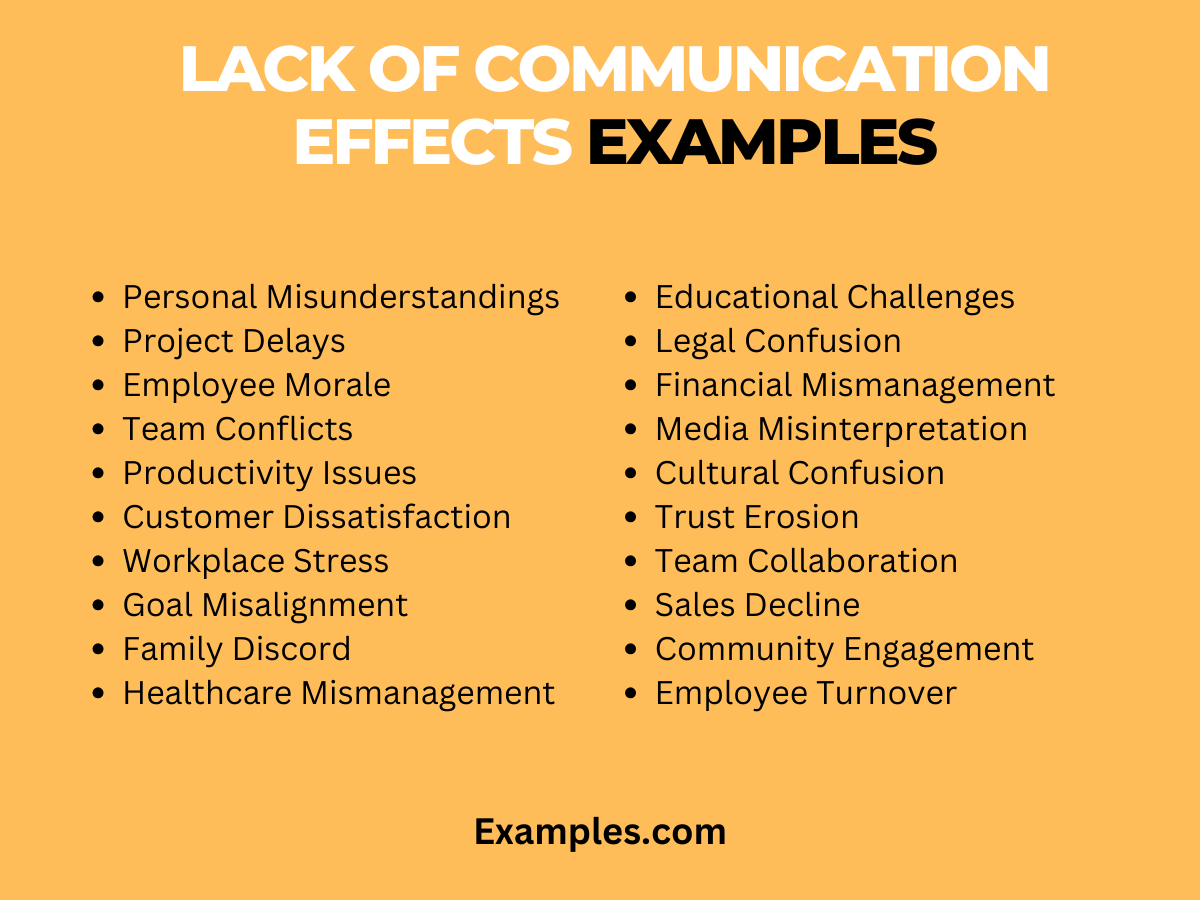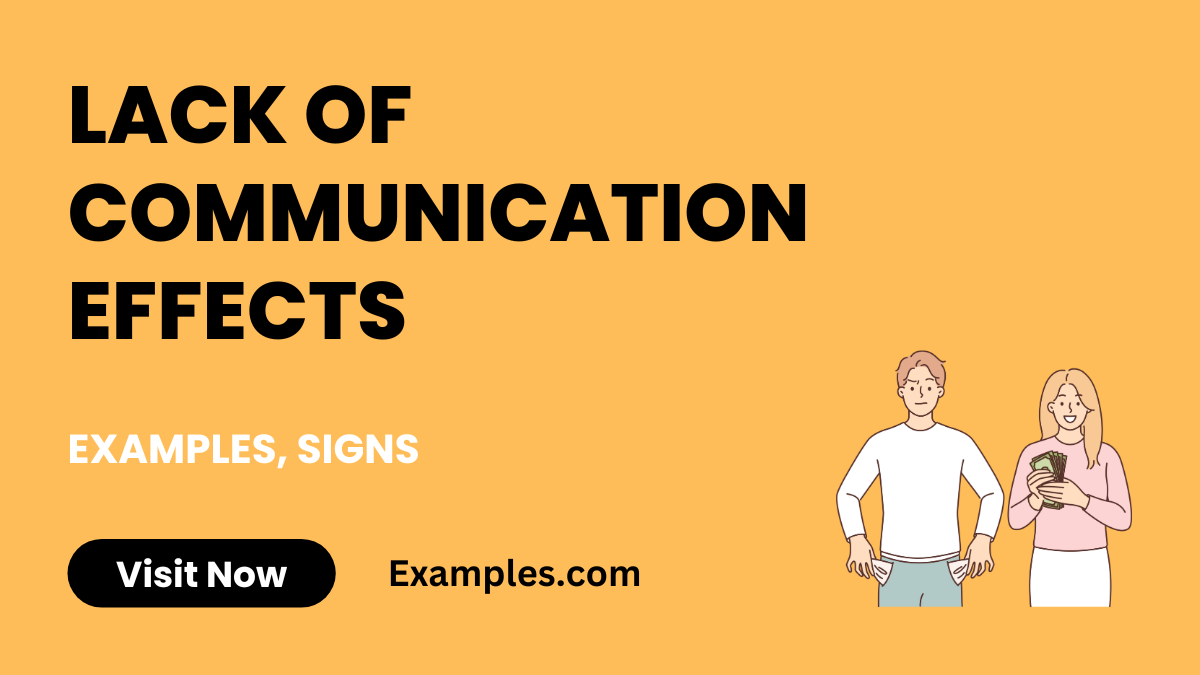20 Lack of Communication Effects Examples
In this comprehensive guide, we explore the wide-ranging effects of lack of communication. Through various communication examples, we examine how communication gaps can lead to interpersonal relationship breakdowns, workplace challenges, and more. Delving into the causes and consequences, from misunderstanding consequences to teamwork dysfunction, this guide offers insights into the impact of poor communication in different areas of life. Whether in personal relationships or professional settings, understanding these effects is crucial for fostering healthier, more effective interactions.
Download Lack of Communication Effects PDF
20 Lack of Communication Effects Examples

In this comprehensive exploration, we delve into 20 unique examples of the effects lack of communication can have across various domains. These examples range from personal relationships to professional settings, illustrating how communication breakdowns can lead to issues like interpersonal relationship breakdown, teamwork dysfunction, and organizational goal misalignment. Each example provides a detailed look into the causes of these communication issues and offers practical solutions. This guide is designed to help understand the diverse impacts of poor communication and how to effectively address them for improved outcomes.
- Misunderstandings in Personal Relationships: Caused by assumptions instead of clear communication. Example: Encourage open and honest dialogues.
- Workplace Project Delays: Result from unclear task delegations.
Example: Implement structured project management communication tools. - Decreased Employee Morale: Stemming from inadequate recognition or feedback.
Example: Regular performance reviews and acknowledgment of achievements. - Conflict Escalation in Teams: Due to unresolved minor disagreements.
Example: Facilitate conflict resolution workshops and open discussions. - Reduced Productivity: Caused by unclear job expectations.
Example: Set clear goals and regular check-ins. - Customer Dissatisfaction: From miscommunication of product features or services.
Example: Provide comprehensive training to customer service representatives. - Workplace Stress Amplification: Due to lack of support or resources.
Example: Create open channels for employees to voice concerns and needs. - Organizational Goal Misalignment: When teams are not aligned with the company’s vision.
Example: Regular company-wide meetings and clear communication of objectives. - Breakdown in Family Relationships: Stemming from lack of open conversations.
Example Family counseling and scheduled family meetings. - Healthcare Mismanagement: Due to poor communication between medical staff and patients.
Example: Implement patient-centered communication strategies. - Educational Challenges: When teachers and students have a communication gap.
Example Encourage feedback sessions and active engagement strategies. - Legal Misunderstandings: Resulting from unclear legal advice or client-lawyer miscommunication. Example: Ensure thorough and simplified explanations of legal terms.
- Financial Mismanagement: Due to unclear financial goals or plans.
Example: Regular financial planning sessions and clear documentation. - Misinterpretation in Media: Misinformation spreading due to unclear reporting.
Example: Fact-checking protocols and clear, responsible journalism practices. - Cultural Misunderstandings: In diverse settings, leading to conflicts.
Example: Cultural sensitivity training and open discussions about cultural differences. - Loss of Trust in Relationships: Stemming from withholding information.
Example: Build trust through transparency and honesty. - Ineffective Team Collaboration: Due to lack of open communication channels.
Example: Team-building activities and collaborative project tools. - Sales Decline: From ineffective communication with customers.
Example: Develop clear, customer-focused communication strategies. - Poor Community Engagement: In public projects or initiatives.
Example: Community meetings and regular, transparent updates. - Employee Turnover: Caused by a lack of communication regarding career growth opportunities.
Example: Career development programs and open discussions about career paths.
Lack of Communication Effects in a Relationship
Lack of communication in relationships can lead to misunderstandings, unresolved conflicts, and emotional distance. It gradually erodes the trust and intimacy that are foundational to any relationship. Recognizing and addressing these issues is vital for maintaining a healthy, supportive partnership.
- Misunderstood Intentions: Assumptions replace open discussions, leading to misunderstandings. Communicate clearly, “I feel upset when I don’t understand your intentions.”
- Unresolved Conflicts: Small issues escalate without proper communication. Address issues directly, “Let’s discuss what happened yesterday to understand each other better.”
- Diminished Emotional Connection: Feelings of loneliness emerge when partners stop sharing. Reconnect by saying, “I miss sharing our daily experiences with each other.”
- Lack of Empathy: Failing to communicate emotions leads to a lack of empathy. Express feelings, “I feel hurt when my concerns seem unnoticed.”
- Decreased Trust: Secrets or withholding information can diminish trust. Build trust, “I believe honesty, even when difficult, strengthens our trust.”
- Avoidance of Tough Conversations: Avoiding difficult topics can create barriers. Initiate dialogue, “It’s important for us to talk about challenging issues.”
- Passive-Aggressive Behavior: Indirect communication leads to unhealthy expression of feelings. Encourage directness, “I prefer open conversation over hints or silence.”
- Loss of Intimacy: Emotional distance reduces physical intimacy. Rekindle intimacy, “Let’s find ways to reconnect both emotionally and physically.”
- Escalating Arguments: Minor disagreements turn into major fights. De-escalate, “Let’s take a moment to calm down before we continue.”
- Breakdown of Partnership: Lack of teamwork in decision-making. Collaborate, “Our decisions are best made when we both contribute our views.”
Lack of Communication Effects in the Workplace
Ineffective communication in the workplace leads to decreased productivity, teamwork dysfunction, and a negative work environment. Understanding these effects helps organizations create strategies to improve communication, fostering a more efficient and harmonious workplace.
- Project Delays: Miscommunication causes misunderstandings in project goals. Clarify objectives, “Let’s review the project timeline and deliverables for clarity.”
- Low Morale Among Employees: Employees feel undervalued and misunderstood. Boost morale, “Your input is important to us; let’s discuss your ideas.”
- Increased Workplace Conflicts: Small misunderstandings escalate into conflicts. Resolve conflicts, “Let’s find common ground to resolve this disagreement.”
- Inefficient Team Collaboration: Teams struggle to work effectively together. Promote teamwork, “Regular team meetings will help us stay aligned and coordinated.”
- Poor Customer Service: Miscommunication affects customer satisfaction. Improve service, “Ensure we understand and effectively address customer needs.”
- Decreased Employee Engagement: Employees disengage due to lack of clear communication. Engage staff, “We value your contributions and want to hear your feedback.”
- Stress and Burnout: Constant communication barriers lead to employee stress. Reduce stress, “Let’s work on clear and stress-free communication channels.”
- Inconsistent Information Sharing: Important updates are not properly disseminated. Streamline information, “Regular briefings will keep everyone updated on key developments.”
- Lack of Recognition: Achievements go unnoticed due to communication gaps. Acknowledge efforts, “We appreciate your hard work and will ensure it’s recognized.”
- Resistance to Change: Changes are met with resistance when not communicated well. Facilitate change, “Clear explanations of changes help in gaining support.”
Signs of Lack Communication
Recognizing the signs of lack of communication is crucial for timely intervention. These indicators help in identifying communication issues, both in personal and professional contexts, allowing for proactive measures to address them.
- Frequent Misunderstandings: Regular occurrences of confusion and misinterpretation.
- Withdrawal or Silence: Individuals becoming more withdrawn or silent.
- Passive-Aggressive Behavior: Indirect expression of dissatisfaction or disagreement.
- Unresolved Disputes: Issues and conflicts remain unresolved.
- Lack of Engagement: Decreased interest or participation in discussions.
- Avoiding Direct Interaction: Preference for indirect communication channels.
- Decreased Transparency: Information is not openly shared.
- Increased Tension: Noticeable tension in interactions.
- Feedback Avoidance: Reluctance to give or receive feedback.
- Lack of Clarity: Ambiguity in messages or instructions.
How Does Communication Affect Marriage?
Communication in marriage is the cornerstone of a healthy relationship. Effective communication fosters understanding, trust, and respect, reducing conflicts and misunderstandings. It allows partners to express their needs, share their feelings, and work collaboratively on solutions, enhancing their emotional connection. Conversely, poor communication can lead to frustration, emotional distance, and unresolved issues. Therefore, maintaining open and honest communication is vital for a strong, enduring marital bond.
- Enhanced Understanding: Effective communication fosters a deeper understanding between partners, reducing misunderstandings and conflicts.
- Improved Conflict Resolution: Open communication allows couples to resolve disputes more effectively and amicably.
- Stronger Emotional Connection: Sharing thoughts and feelings strengthens the emotional bond, enhancing relationship satisfaction.
- Better Problem-Solving: Communication facilitates collaborative problem-solving, leading to healthier resolutions.
- Increased Trust and Transparency: Regular, honest communication builds trust and transparency in the relationship.
What are the Effects of Face-to-face Communication?
Face-to-face communication is impactful due to its immediacy and richness. It allows for a deeper connection through non-verbal cues like body language and facial expressions, enhancing understanding and empathy. This direct interaction fosters trust and authenticity, often leading to more effective and meaningful conversations. It also allows for immediate feedback and clarification, reducing the likelihood of misunderstandings. In personal and professional settings, face-to-face communication is crucial for building strong relationships and resolving issues effectively.
- Non-verbal Cues: Provides a wealth of non-verbal cues like facial expressions and body language, enhancing understanding.
- Immediate Feedback: Allows for instant feedback and clarification, reducing misunderstandings.
- Stronger Connections: Builds stronger personal connections, fostering trust and empathy.
- Enhanced Clarity: Face-to-face interaction often leads to clearer communication, reducing the chance of errors.
- Emotional Expression: Facilitates the expression and perception of emotions more effectively.
How Do You Overcome Lack of Communication?
Overcoming lack of communication requires a proactive approach. Start by acknowledging the issue and its impact on relationships or teamwork. Practice active listening, giving full attention to others and showing empathy. Clearly and respectfully express your own thoughts and feelings. Encourage open dialogue and create a safe space for sharing without judgment. Use clarifying questions to avoid misunderstandings. Finally, seek feedback and be willing to adapt your communication style to improve mutual understanding and connection.
- Active Listening: Practice active listening to fully understand the other person’s perspective.
- Clear Expression: Clearly express thoughts and feelings without ambiguity.
- Regular Check-ins: Schedule regular times for open and honest discussions.
- Feedback Encouragement: Encourage and provide constructive feedback.
- Empathy Practice: Show empathy to understand the emotions behind words.
What are the Reactions for Lack of Communication?
Reactions to lack of communication include frustration, misunderstandings, conflict escalation, decreased trust, and emotional disconnect.
Can Lack of Communication Ruin a Relationship?
Yes, lack of communication can ruin a relationship by fostering misunderstandings, breeding resentment, eroding trust, and weakening emotional connections.
How to Improve Communication?
Improve communication by practicing active listening, expressing thoughts clearly, being open to feedback, showing empathy, and maintaining regular, honest dialogues.
The effects of lack of communication, ranging from personal relationships to professional environments, are profound and multifaceted. This guide highlights the importance of effective communication and offers strategies to overcome communication barriers. By understanding and addressing these challenges, we can foster healthier interactions, stronger relationships, and more cohesive teams, ultimately enhancing overall well-being and productivity.



